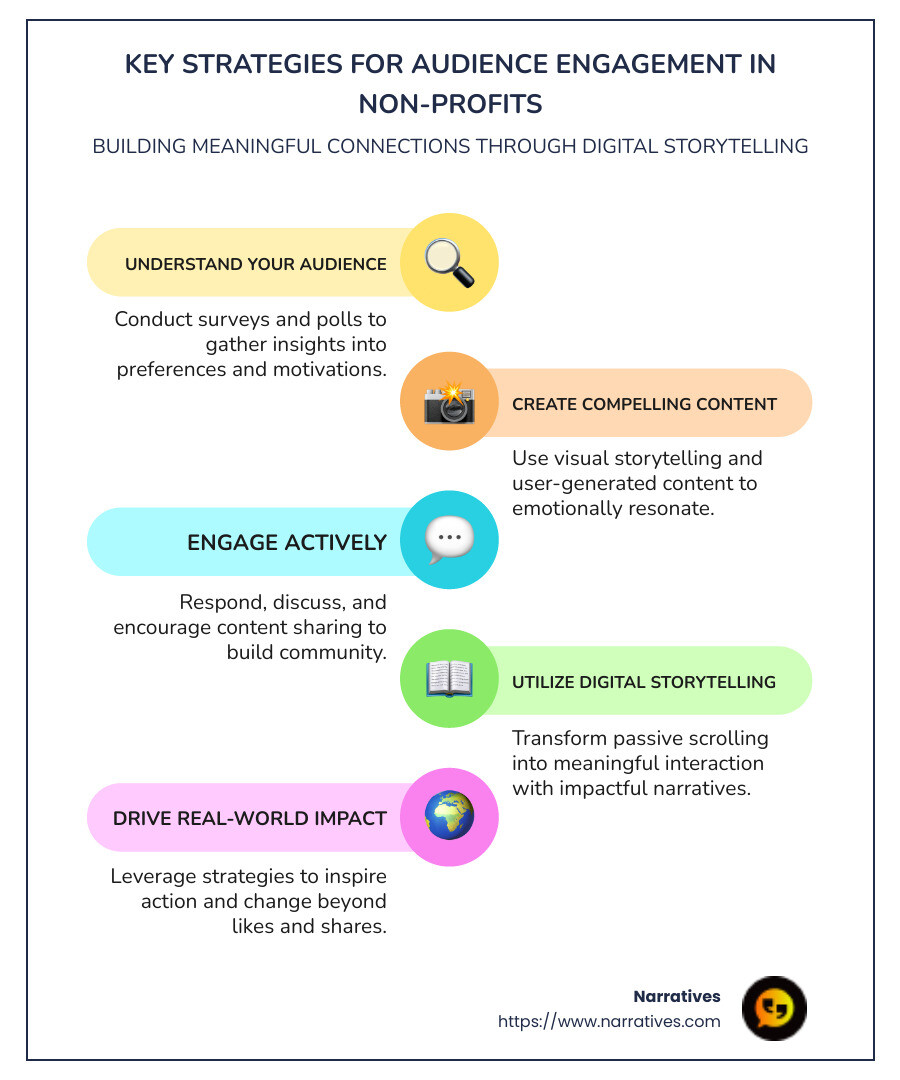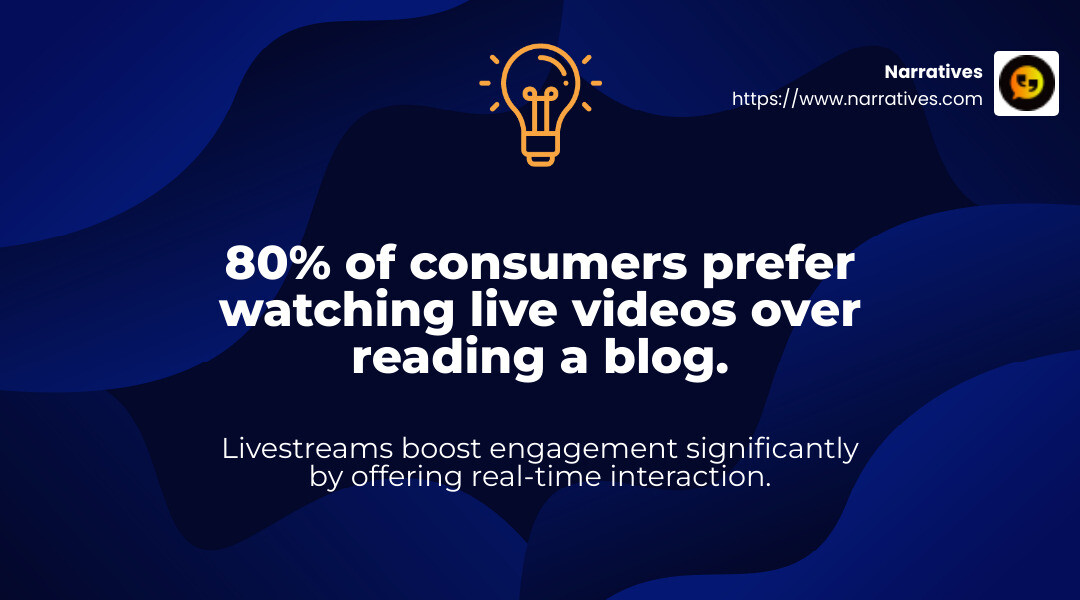From Awareness to Action: Mastering Audience Engagement for Non-Profits

Audience engagement for non-profits is the backbone of successful digital storytelling. Non-profits have the unique opportunity to amplify their mission by effectively engaging their audience online. Here’s how:
- Understand Your Audience: Use surveys and polls to gather insights into their preferences and motivations.
- Create Compelling Content: Use visual storytelling and user-generated content to resonate emotionally.
- Engage Actively: Respond, discuss, and encourage content sharing to build a sense of community.
Digital storytelling transforms passive scrolling into meaningful interaction. It’s about more than just shares and likes; it’s about inspiring action and change.
Today, non-profits can reach more people than ever. With the right strategies, these organizations can not only raise awareness but also drive real-world impact.

Understanding Your Audience
Identifying Target Audience
Before diving into content creation, it's crucial to identify your target audience. This means understanding who they are and what makes them tick. Start by examining demographics like age, gender, income, and location. Are they urban dwellers or living in rural areas? This information helps in tailoring your outreach efforts.
Next, dig into psychographics—the interests, values, and lifestyles of your audience. Are they passionate about environmental conservation, social justice, or community building? Knowing these aspects allows you to align your mission with their values, creating a stronger connection.
Communication preferences are equally important. Do they prefer emails, social media updates, or text messages? Tailor your communication strategy to meet them where they are most comfortable.
Engaging with Audience Insights
Once you have a clear picture of your audience, it’s time to engage with their insights. Conduct surveys and polls to gather direct feedback. This not only helps you understand their needs but also makes them feel valued and heard.
To make this process effective, create detailed audience personas. These are fictional profiles representing your ideal supporters. For example, a persona might be "Erin Matthews," a 35-year-old marketing manager interested in sustainable living. She prefers email updates and hands-on volunteer opportunities.

Use these personas to craft messages that resonate deeply with your audience. Highlight the tangible impacts of their contributions, like the number of trees planted or community programs supported.
Incorporating feedback from your audience is also essential. Regularly ask for their opinions on your initiatives and be open to adapting your strategies based on their responses. This not only strengthens your relationship with them but also ensures your efforts are aligned with their expectations.
By thoroughly understanding your audience's demographics, psychographics, and preferences, you can tailor your strategies to engage them meaningfully. This approach transforms your audience from passive observers into active participants in your mission.
Next, we’ll explore how to create compelling content that captivates and engages your audience.
Creating Compelling Content
Creating content that resonates with your audience is essential for any nonprofit. It's not just about posting updates; it's about telling stories that connect emotionally and inspire action.
Leveraging Video and Multimedia
Videos are a powerful way to engage your audience. They allow you to share stories visually, which can be more impactful than text alone. Consider using platforms like TikTok and Instagram Reels to share short, engaging clips. Behind-the-scenes videos or "a day in the life" content can humanize your organization and create a stronger bond with your supporters.
Livestreams are another excellent tool. They offer real-time interaction and can be used for Q&A sessions, virtual tours, or live events. According to research, 80% of consumers prefer watching live videos over reading a blog. This real-time connection can boost engagement significantly.

Utilizing Hashtags and Static Posts
Hashtags are crucial for increasing your content's visibility. Use event-themed hashtags like #MentalHealthAwarenessMonth or #WorldRefugeeDay to reach a wider audience. These hashtags help people find your content and connect with your cause.
Carousel posts on platforms like Instagram allow you to share multiple images or videos in one post. This format is perfect for storytelling, as you can guide your audience through a series of images or messages that build a narrative. It's a great way to showcase different aspects of a project or highlight multiple success stories.
User-generated content is another strategy to consider. Encourage your supporters to share their experiences and tag your organization. This not only provides you with fresh content but also fosters a sense of community and involvement. When people see others actively supporting your cause, they are more likely to engage themselves.
By leveraging video and multimedia effectively and utilizing hashtags and static posts, you can create content that captivates your audience and drives engagement. This approach not only improves your storytelling but also strengthens your community's connection to your mission.
Next, we’ll discuss the importance of consistent and strategic posting to maintain engagement.
Consistent and Strategic Posting
Consistency is key for audience engagement for non-profits. Regular updates keep your audience informed and engaged, helping maintain a steady connection with your supporters.
Social Media Management Tools
Using social media management tools can simplify your posting process. These tools allow you to schedule posts in advance, ensuring that your content goes live at optimal times without needing constant attention.
Scheduling: Plan your posts for times when your audience is most active. According to research, platforms like Facebook and Instagram have peak engagement times that vary by audience. Scheduling tools can help you hit these sweet spots consistently.
Content Calendar: Develop a content calendar to plan your posts. This not only helps in maintaining a regular posting schedule but also ensures a diverse mix of content types, such as infographics, stories, and appeals. A well-organized calendar can also help you prepare for key events or campaigns.
Analytics: Regularly review analytics to understand what content resonates most with your audience. Metrics such as engagement rates, shares, and comments can provide insights into what works and what doesn't. Use this data to refine your strategy and focus on the most impactful content.
Platform-Specific Strategies
Different platforms require custom strategies to maximize engagement.
Facebook: Known for its slightly older demographic, Facebook is ideal for sharing detailed stories and updates. Use it to post links to your website or blog, and consider using Facebook Events to engage with your community.
Instagram: A visual-first platform, Instagram is perfect for storytelling through images and videos. Use features like Stories and Reels to share behind-the-scenes content and quick updates. Carousel posts can effectively showcase multiple aspects of a campaign or event.
LinkedIn: This platform is best for professional networking and sharing thought leadership content. Use LinkedIn to connect with other organizations, share success stories, and engage with industry discussions. It’s particularly effective for B2B engagement and partnerships.
TikTok: With its younger audience, TikTok is a great place for creative and engaging video content. Use it to share impactful stories or challenges that encourage user participation. Consider collaborating with influencers to extend your reach and connect with new audiences.
By using social media management tools and crafting platform-specific strategies, your nonprofit can maintain a consistent and strategic posting schedule. This approach not only keeps your audience engaged but also maximizes the impact of your social media presence.
Next, we’ll explore how to leverage social media ads to further boost your engagement and reach.
Leveraging Social Media Ads
Targeted Advertising Strategies
Social media ads can be a game-changer for non-profits looking to expand their reach and engage new supporters. Here’s how to make the most of them.
Google Ads
Google Ads can significantly boost your visibility. By appearing in Google Search results, on partner websites, and even on Google Maps, your nonprofit can reach a wide audience.
Ad Grants: Google offers up to $10,000 per month in free search advertising for eligible non-profits. This is a fantastic opportunity to increase your reach without straining your budget. Learn more about the Google Ad Grants application process to get started.
Campaign Updates: Regularly update your ads to highlight new campaigns or initiatives. Use the Google Ads manager to pin headlines and descriptions, ensuring your message is clear and impactful.
Meta Ads
Meta’s platforms, Facebook and Instagram, are powerful tools for reaching diverse audiences.
Audience Segmentation: Divide your audience into categories such as previous donors and potential new supporters. This allows for custom messaging that resonates with each group.
Impactful Ads: Create ads that showcase the tangible impact of donations. Highlight stories of change and outline how additional support can help further your mission.
TikTok Campaigns
TikTok is all about creativity and storytelling through video. It’s perfect for reaching a younger audience with engaging content.
Brand Awareness: Use TikTok to run brand awareness campaigns. These can help you connect with new audiences and build a community of supporters.
Authentic Content: Encourage donors or beneficiaries to create TikToks for your campaign. This approach makes ads feel native to the platform and ensures they are relatable and engaging.
By leveraging these targeted advertising strategies, your nonprofit can effectively use social media ads to improve audience engagement. Next, we’ll explore some frequently asked questions about audience engagement for non-profits.
Frequently Asked Questions about Audience Engagement for Non-Profits
How often should a nonprofit post on social media?
Consistency is key when it comes to social media. For most nonprofits, posting four to six times a week is a good starting point. This frequency helps maintain visibility and keeps your audience engaged without overwhelming them. However, each platform has its own norms. For example, TikTok content takes longer to produce, so posting less frequently there is common.
A content calendar can be a lifesaver in maintaining consistency. It helps you plan and schedule posts in advance, ensuring a steady stream of content. Experimenting with different frequencies can also offer insights into what works best for your audience.
What are the best social media platforms for nonprofits?
Choosing the right platform depends on your goals and audience. Here's a quick overview:
Facebook: This platform is ideal for reaching an older demographic. It excels in driving traffic, thanks to its link-sharing capabilities.
Instagram: Perfect for visual storytelling. Use it to share compelling images and stories that resonate with a younger audience.
LinkedIn: Best for professional networking and connecting with corporate partners. It's a great platform for sharing thought leadership and organizational updates.
TikTok: Fantastic for engaging a younger audience with creative and fun content. Its video format allows for storytelling that feels authentic and relatable.
How can nonprofits measure engagement success?
Measuring engagement is crucial for understanding the effectiveness of your strategies. Here are some key metrics to track:
Engagement Rate: Look at likes, comments, and shares to gauge how well your content resonates with your audience.
Analytics Tools: Use tools like Facebook Insights and Instagram Analytics to get detailed reports on audience interaction and content performance.
Feedback: Direct feedback from your audience, through comments or surveys, can provide valuable insights into what they find engaging or useful.
Tracking these metrics helps you refine your strategies and ensure your efforts are truly connecting with your audience.
By understanding and implementing these practices, nonprofits can master audience engagement on social media. Next, we'll dive into the conclusion, exploring the power of digital storytelling and community-driven narratives.
Conclusion
Audience engagement for non-profits isn't just about getting likes or shares. It's about crafting meaningful connections through digital storytelling and community-driven storytelling. At Narratives, we believe that every story has the power to inspire action and foster trust. Our mission is to help non-profits leverage these stories to make a real impact.
Digital storytelling allows organizations to present their missions in a way that resonates emotionally with supporters. By using videos, multimedia content, and authentic narratives, non-profits can showcase their impact in the communities they serve. This approach not only increases visibility but also builds a loyal supporter base eager to champion the cause.
Community-driven storytelling amplifies voices that are often underrepresented. By involving the community in content creation, non-profits can ensure that their messaging is not only authentic but also deeply connected to the people they aim to help. This participatory approach fosters a sense of belonging and empowers supporters to become advocates for the mission.
As we wrap up this guide, effective audience engagement is a journey. It requires consistent effort, creativity, and a deep understanding of your audience. At Narratives, we're here to partner with you every step of the way, helping you master the art of storytelling and transform awareness into action.
For more insights and resources on how we can assist your organization, learn more about our services. Together, we can lift your stories and drive meaningful change.


